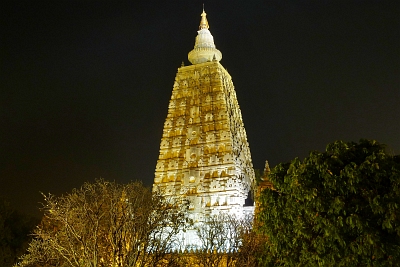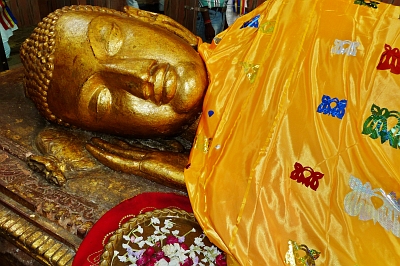In Buddha's Footsteps
(vero;2019-Feb-28)
As we were planning our itinerary and studying the map, we realised that we would be passing near several historic Buddhist sites. Those sites were first Nalanda and Bodhgaya in the state of Bihar, then Lumbini in Nepal and finally Kushinagar and Sarnath in the state of Uttar Pradesh. It was too tempting not to include them in our route and we ended up designing a “Buddha Circuit”, a small trip within the trip.
The Buddha himself (born 566 BC - died 486 BC) is said to have delivered lectures in a mango grove named Pavarika in the vicinity of the village of Nalanda; furthermore, one of his two chief disciples, Shariputra, was born in the area and later attained nirvana there. But it was not until the fifth century AD that the site started developing into an important religious centre, eventually becoming a highly reputed centre of knowledge, an university which fame attracted thousands of students and monks from all over Asia. Its decline started in the eighth century with the rise of Hinduism, the final blow being delivered in 1199 AD when Muslim invaders sacked and looted Nalanda.
Alas, we did not make it to Nalanda. By the time we entered Bihar, we had already been five and a half weeks in India and the pull of Nepal was becoming stronger and stronger. The detour via Rajgir to visit the ruins did not seem so appealing anymore so we decided to head directly to Bodhgaya. We should have maybe demonstrated more stamina but on the other side, we might come again to this region at one point in time, so nothing's lost.
Bodhgaya:
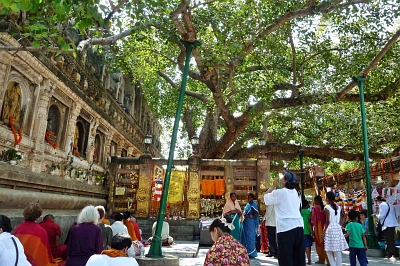 The Buddha was born Siddhartha Gautama, son of a king and raised accordingly, sheltered from the miseries of the outside world. He married at the age of 16 living a life of total seclusion until the day when aged 29, he left his palace for the first time to meet his subjects. One of his first encounters was with an old man and on further outings he came across a sick and dying man and saw a decaying corpse, all sights which shocked him and confronted him brutally with the bitter realities of life. Having met a wandering ascetic, he felt inspired to follow his example in the hope of finding a way to overcome the human destiny of ageing, sickness, and death. To do so and dedicate himself exclusively to his quest, he decided to renounce his riches and leave his kingdom and family.
The Buddha was born Siddhartha Gautama, son of a king and raised accordingly, sheltered from the miseries of the outside world. He married at the age of 16 living a life of total seclusion until the day when aged 29, he left his palace for the first time to meet his subjects. One of his first encounters was with an old man and on further outings he came across a sick and dying man and saw a decaying corpse, all sights which shocked him and confronted him brutally with the bitter realities of life. Having met a wandering ascetic, he felt inspired to follow his example in the hope of finding a way to overcome the human destiny of ageing, sickness, and death. To do so and dedicate himself exclusively to his quest, he decided to renounce his riches and leave his kingdom and family.
For the next six years Siddhartha lived the life of a wandering beggar, following the teachings of five ascetics. At some point, with still no answer as to why humanity seemed doomed to suffering, he turned to self-mortification, enduring pain and fasting to near starvation. But this did not help either and he came to realise that there must be other ways to enlightenment. He decided to leave the five ascetics and eventually came to Bodhgaya where he at last accepted food from a village girl and vowed to stay there and meditate until he would find the answer which was eluding him. He finally attained enlightenment after 49 days spent in meditation under the Bodhi tree and articulated his “philosophy”, the “Noble Eightfold Path” or Middle Way for others to follow, thus becoming Buddha “the Awakened One”.
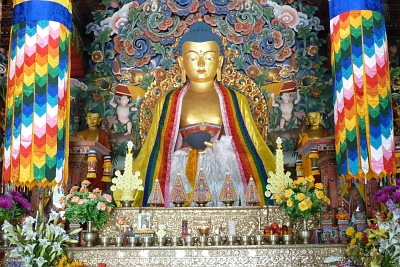 A big, peaceful temple, the Mahabodhi Temple, has been built next to a descendent of the original Bodhi tree and Bodhgaya has become an important pilgrimage destination for Buddhists all over the world. Throngs of pilgrims come to the place to worship and a multitude of monasteries and temples have mushroomed all over the town.
A big, peaceful temple, the Mahabodhi Temple, has been built next to a descendent of the original Bodhi tree and Bodhgaya has become an important pilgrimage destination for Buddhists all over the world. Throngs of pilgrims come to the place to worship and a multitude of monasteries and temples have mushroomed all over the town.
After the long train ride from Bubaneshwar, arriving in quiet and relaxed Bodhgaya was a very pleasant surprise. We stayed three days and really enjoyed our stay there. We visited many monasteries, our favourites being the Tibetan Karma Temple, the Indosan Nippon Japanese Temple and the Bhutanese Temple. We spent a lot of time in the Karma Temple: it reminded us of Nepalese monasteries and was very active with many monks, young and old, chanting 30 minute long mantras which were not so monotonous as the ones we heard in other places, starting a new litany as soon as the previous one winded off in the way old records slowly come to a halt on a gramophone. We paid a visit every day, even spending one and a half hour there on our second day, soaking up the atmosphere. It was not boring at all: a little dog was wandering among the monks and getting petted by all, many Indian tourists came and paid their respects and milk tea was being regularly served to monks and devotees alike.
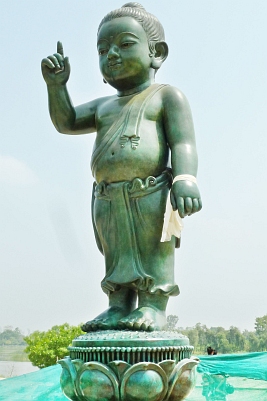 We also liked the murals in the Bhutanese monastery, in pastel colours and depicting the life of Buddha. The Japanese monastery was plain with strange murals depicting crowds of devotees in prayer. But the big draw of course was the Mahabodhi Temple: set in nice gardens, it is very atmospheric and we spent a long time sitting next to the Bodhi tree and observing the pilgrims. Like others, we waited for leaves to fall and collected some which we offered to two of our Buddhist friends in Kathmandu and France.
We also liked the murals in the Bhutanese monastery, in pastel colours and depicting the life of Buddha. The Japanese monastery was plain with strange murals depicting crowds of devotees in prayer. But the big draw of course was the Mahabodhi Temple: set in nice gardens, it is very atmospheric and we spent a long time sitting next to the Bodhi tree and observing the pilgrims. Like others, we waited for leaves to fall and collected some which we offered to two of our Buddhist friends in Kathmandu and France.
Lumbini:
Lumbini is the birthplace of the Buddha and after Bodhgaya the second of the places we visited on our “Buddhist circuit”. The legend goes that on the night he was conceived his mother Queen Mayadevi had a dream of a white elephant entering her right side, an auspicious sign that the child to come would have a great destiny. As she neared delivery, she set off to her parents' palace to give birth there, but the baby came sooner as expected and Buddha was born on a full moon night in the gardens of Lumbini, his mother holding on to the branch of a Sal tree for support. Just after his birth, Buddha is said to have walked seven steps, a lotus flower appearing after each one, and uttered following words: I am chief of the world. Eldest am I in the world. Foremost am I in the world. This is the last birth. There is now no more coming to be. Well... if that's not something ;-)
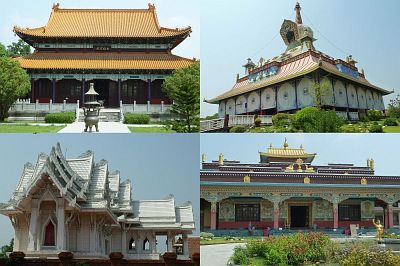 As far as historic ruins go, there is not a lot to see on the ground in Lumbini: just a few low walls delimiting ancient monasteries, a sacred Bodhi tree, an ancient bathing pond, the Mayadevi Temple, erected on the spot where Buddha was born and a so-called pillar of Ashoka bearing witness that Ashoka, emperor of the Maurya Empire, visited the place in the third century BC and identified it as the birthplace of the Buddha. From early morning to early evening, pilgrims from various countries perform chanting and meditation at the site but for tourists like us the real attraction of Lumbini are the many monasteries built around the area by Buddhist countries and organisations from all over the world, each displaying their own architecture and style. Lumbini is the place to go for a real world tour of Buddhist architecture, quite a rewarding experience. This was our second visit in Lumbini, the first one being in 2008 and we could see that a lot of construction work had been done in those five years with many new monasteries around and even more still under construction.
As far as historic ruins go, there is not a lot to see on the ground in Lumbini: just a few low walls delimiting ancient monasteries, a sacred Bodhi tree, an ancient bathing pond, the Mayadevi Temple, erected on the spot where Buddha was born and a so-called pillar of Ashoka bearing witness that Ashoka, emperor of the Maurya Empire, visited the place in the third century BC and identified it as the birthplace of the Buddha. From early morning to early evening, pilgrims from various countries perform chanting and meditation at the site but for tourists like us the real attraction of Lumbini are the many monasteries built around the area by Buddhist countries and organisations from all over the world, each displaying their own architecture and style. Lumbini is the place to go for a real world tour of Buddhist architecture, quite a rewarding experience. This was our second visit in Lumbini, the first one being in 2008 and we could see that a lot of construction work had been done in those five years with many new monasteries around and even more still under construction.
Kushinagar is the place where the Buddha died, the third stop on our “Buddhist circuit”. This is a small sleepy village and makes for a nice day-trip from Gorakhpur. The main point of interest is of course the Ramabhar Stupa, a plain stupa built by the emperor Ashoka over the spot where the Buddha was cremated but we by far preferred the Maha Parinirvana Temple where one can admire a very beautiful and graceful 6-m statue of a Reclining Buddha dating from the fifth century AD. We sat quite a long time admiring the statue and observing the many pilgrims paying their respects. There are also of course the obligatory monasteries scattered around town but by far not on the scale of Lumbini or Bodhgaya.
Sarnath:
Sarnath, near Varanasi, was the fourth and last stop on our “Buddhist circuit”. After having attained enlightenment and formulated his philosophy of the Middle Way, Buddha decided to look for the five ascetics he had left to go to Bodhgaya. He thought, and rightly so, that they would be particularly receptive and would understand easily what was revealed to him under the Bodhi Tree. He found his five former companions in Sarnath where he delivered his first sermon and enlightened them with his teachings in the Deer Park. Together they founded the Sangha (or community of the enlightened ones) and stayed in Sarnath for a while, teaching others to become enlightened as well. When they reached the number of sixty enlightened followers, Buddha eventually sent them in all directions to teach the Middle Way and propagate Buddhism.
Sarnath is an easy day-trip from Varanasi. It is even more sleepy than Kushinagar and there is not a great deal to see on the ground: a few ruins, a few nondescript monasteries but still, it was nice to be there.
Our conclusions:
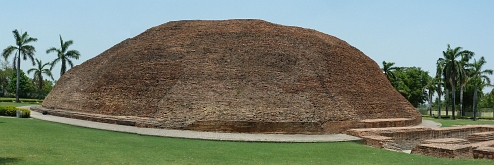 In case anyone now assumes that we are Buddhists, no, we're not. There are many good ideas in Buddhism, if seen as a philosophy of life (as the Buddha intended) but there are also too many things, like the karma bit and reincarnation, which we do not accept. Back home reflecting on our “Buddhist Circuit” we came up with following ranking but as always, it is best to go there and see for yourselves!
In case anyone now assumes that we are Buddhists, no, we're not. There are many good ideas in Buddhism, if seen as a philosophy of life (as the Buddha intended) but there are also too many things, like the karma bit and reincarnation, which we do not accept. Back home reflecting on our “Buddhist Circuit” we came up with following ranking but as always, it is best to go there and see for yourselves!
- For the historic monuments and ruins: 1. Bodhgaya - 2. Kushinagar - 3. Sarnath - 4. Lumbini
- For the monasteries: 1. Lumbini - 2. Bodhgaya - 3. Kushinagar - 4. Sarnath
- For the overall experience: 1. Bodhgaya - 2. Lumbini - 3. Kushinagar - 4. Sarnath
Want to read more? Go back to Quintessential Indian Railways or go on to Email Updates or go up to Blog
$ updated from: Blog.htxt Mon 28 Apr 2025 14:55:30 trvl2 — Copyright © 2025 Vero and Thomas Lauer unless otherwise stated | All rights reserved $




